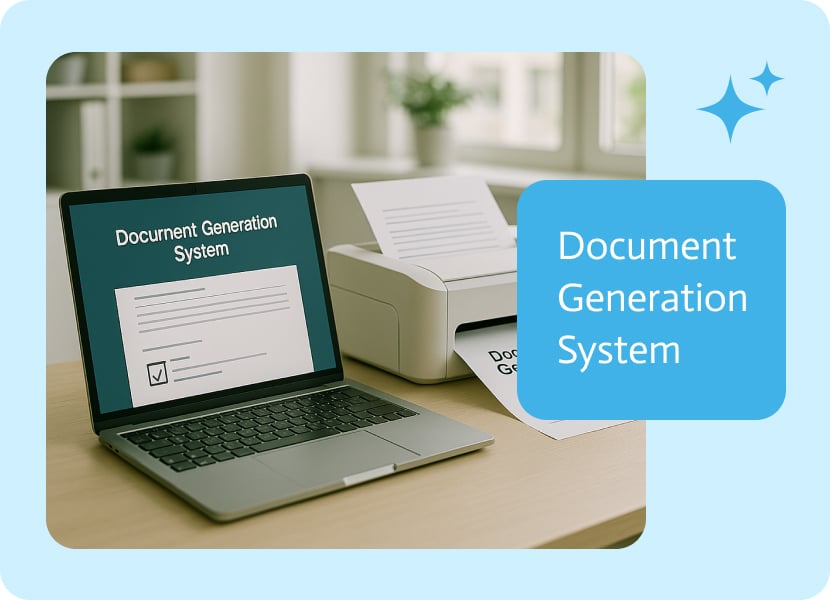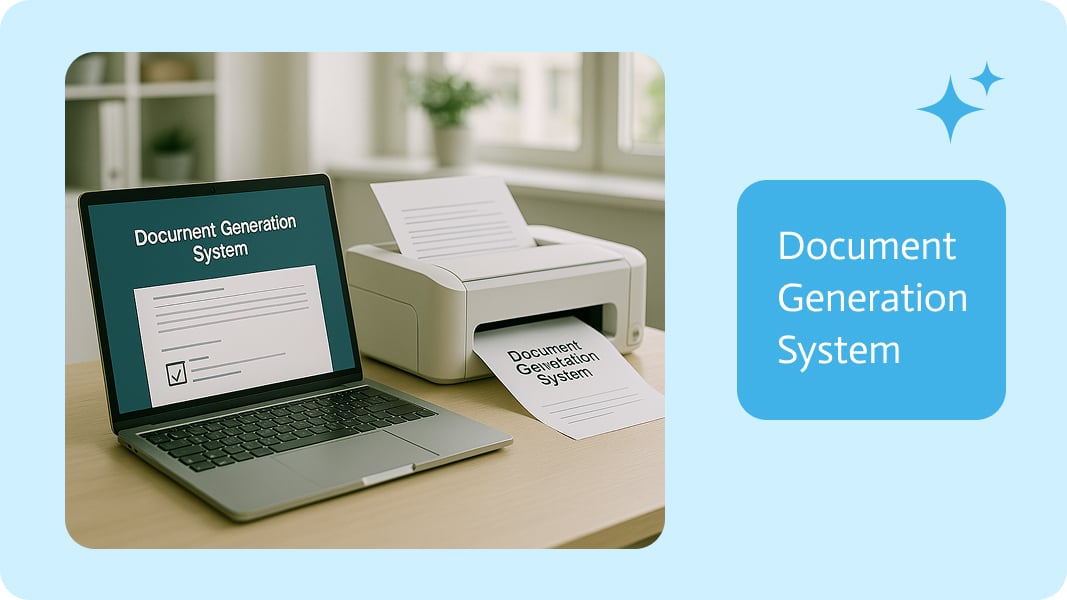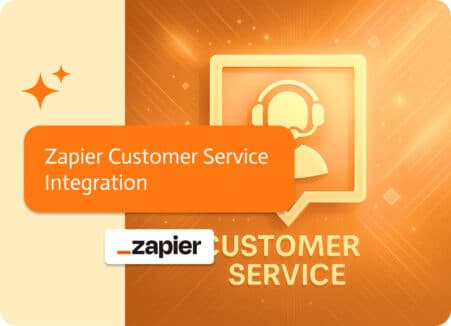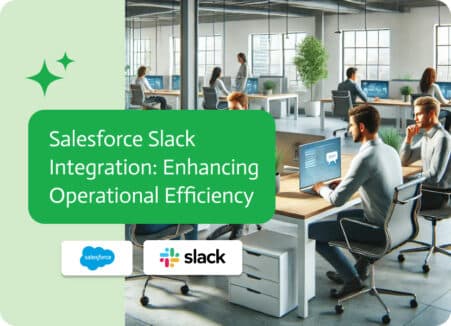

Document Generation System
Imagine owning a printing press that could print entire business documents with all the necessary information, flawless formatting, accurate legal terms, and your brand imprinted on them, as opposed to just printing ink on paper. That’s basically what a document generation system does, but instead of setting type by hand like a monk from medieval times, you connect it to your business systems and let it do its thing.
The infrastructure that automatically transforms your unprocessed data into completed documents is called a document generation system. It consists of a distribution network, a business logic processor, a data transformer, and a template engine. Give it client data, product specifications, pricing guidelines, and legal requirements, and it will generate proposals, contracts, bills, reports, and pretty much any other document your company needs to run.
Here, the “system” component is extremely important. You can’t just install this software and move on. Your CRM, ERP, databases, processes, and teams are all impacted by this interlinked network. When it functions properly, it turns into your company’s circulatory system, silently pumping out the paperwork that keeps everything going while no one even notices.
The Anatomy of a Document Generation System
The Template Library: Your Document DNA
Treat templates as your documents’ genetic code. Templates contain instructions on how to generate documents, just as DNA contains instructions for creating living things. Unlike DNA, however, you can change these guidelines as your company changes.
A good template library is more than just a Word document folder. Templates have versions, approval processes, restrictions on access, and metadata in this managed vault. The proposal templates belong to marketing. Contracts belong to Legal. The invoices belong to finance. While anyone can create from these templates, not everyone has the ability to edit them. Governance is what keeps your meticulously designed templates from becoming Frankensteins.
In a proper system, templates also inherit each other’s properties. establish a master template with the header, footer, and styling of your business, and child templates will automatically inherit those components. Once you update your logo, it will be reflected in all of the templates. Because of this inheritance structure, you won’t have to keep hundreds of nearly identical templates that gradually diverge as users make local changes.
The most sophisticated engines allow templates to call other templates. Your standard pricing table template, which is derived from your terms and conditions template, which makes reference to your legal disclaimers template, may be embedded in your proposal template. Because it is entirely based on templates, you can build once and reuse indefinitely.
The Data Integration Layer: The Nervous System
The integration layer helps facilitate the communication between your document generation system and the rest of your technology framework. This is where things start to get interesting because your company’s data is likely spread across 47 different locations, none of which were intended to cooperate.
Modern document generation systems require adaptability for your custom systems, legacy databases, and that one Excel file that somehow became mission-critical, even though they come with pre-built connectors to popular platforms like Salesforce, but also to NetSuite, Oracle, SAP etc. All of this is managed by the integration layer using webhooks, file imports, database connections, APIs, and occasionally just plain willpower.
The data mapping intelligence is what gives this layer its true systematic nature. The “Account Name” in Salesforce must match the “Customer” in your ERP and the “Company” in your billing system, according to the system. It must understand that dates should format according to the locale, dollar amounts should round to two decimals, and empty fields should show “N/A” rather than leaving unsightly blank spaces.
In order to prevent bombarding your source systems with queries each time a document is generated, the best systems also cache frequently accessed data. In order to adhere to API rate limits, they queue batch requests. They use exponential backoff to retry unsuccessful connections. The modest infrastructure that makes the magic appear effortless.
The Logic Engine: The Brain
Here’s where your document generation system pays off. With the speed of software, the logic engine automatically carries out your business rules and all of the “if this, then that” choices that people currently make.
“Include executive escalation clauses if the contract is worth more than $100,000. Include a section on HIPAA compliance if the client is in the medical field. Personal guarantee is required if the terms of payment are NET-60. If this is a renewal, note the modified terms and make reference to the prior contract number.
It could take five minutes for a human to process these rules, and sometimes they will forget one. They are processed in milliseconds by the logic engine, which never forgets. Never. even on a Friday afternoon, in a month-end emergency, and even when the 10,000th document of the day is being processed.
The reasoning can become extremely intricate. The system can perform almost any logic expression, including multi-level conditionals, embedded rules, calculations based on numerous variables, lookup tables, date computations, and string transformations. The challenge lies in crafting these guidelines in a way that makes them testable, maintainable, and accessible to those without a computer science background.
The Generation Engine: The Factory Floor
After loading the template, retrieving the data, and processing the logic, the document still needs to be assembled. The generation engine is doing more work than you might imagine.
Your template structure and data payload are then rendered into the final document format, any format you require. It involves applying fonts, managing headers and footers, formatting tables, positioning images, handling page breaks, and taking care of all the little details that make documents look elegant and not like they were generated by a computer.
Here, performance is important. Creating a proposal that is only three pages long? It ought to be instantaneous. producing 5,000 invoices in bulk? You should be done before your coffee cools down. Both basic documents and intricate multi-section reports with charts, tables, and embedded images must be handled by the generation engine, which must be quick without compromising quality.
The Distribution Network: The Postal Service
Creating documents is just half the challenge. The distribution network plays a crucial role in ensuring that they reach the appropriate individuals via the appropriate channels.
The delivery of emails with appropriate attachments and customized messages. Upload to shared drives or customer portals. Post to systems for managing documents. Encourage the use of signature platforms such as DocuSign. Archive to repositories for compliance. Each document type’s routing rules are known by the distribution network, which automatically applies them.
Knowing who needs what is another aspect of smart distribution. Legal, finance, the customer, and the sales representative should all receive signed contracts; however, different stakeholders should receive different versions with redacted prices. Depending on the contract value, notify the appropriate approval chains. In the event that documents are not signed on time, initiate follow-up procedures.
Why “System” Is the Important Word
You could use a basic document generator, something that takes a template and fills in some fields and call it a day, its what many companies do after all. They are also the ones who continue to struggle with manual workflows, disorganized documents, and teams that spend half of their time reformatting.
A document generation system differs in that it is intended to be an infrastructure instead of a tool. On top of it, you construct. You incorporate it thoroughly into your business processes. You depend on it in the same manner that you depend on email or your CRM; it simply exists, functions, and supports all of your other activities.
Over time, this methodical approach compounds. Every new template expands upon earlier efforts. Every integration facilitates the subsequent one. More complex procedures are made possible by each workflow automation. After a year, you’ve created something more than just a productivity trick, you’ve made something truly strategic.
What Makes a Document Generation System Actually Good?
It Grows Along with You
You’ll get underway with the document workflow that you find most painful, such as employment contracts or sales proposals. An effective system makes the initial workflow so successful that adding more document types, integrations, and teams comes naturally.
Instead of making this expansion exponentially more difficult, the system should make it simple. Since you are familiar with the patterns, adding your tenth template ought to be easier than adding your first. Since you are familiar with the procedure, connecting your fifth data source ought to be quicker than connecting your first.
Its Not Quite Informative
Every system has occasional failures. Data sources go down, templates have bugs, and edge cases appear that nobody anticipated. What happens when things break is what distinguishes good systems from garbage.
Effective systems provide you with the precise details of what went wrong, where it happened, and why. They record enough information to diagnose problems without overwhelming you with unrelated information. They fail partial operations gracefully instead of taking down the entire system. They offer unambiguous routes to healing.
A confusing error message should never leave you wondering what the system is attempting to tell you. If so, it’s the system, not you that’s got the problem.
Document Generation Systems With Noca AI
Noca developed its document generation system for companies that require it to do more than just operate technically. This calls for governance tools that allow you to grow without the chance of losing control, intelligent defaults that handle 80% of use cases automatically, and an obsession with the integration layer (since that’s where most systems break).
Above all, Noca’s strategy is predicated on your evolution. Your initial attempt won’t be your final one. You’ll need to update your original templates, info sources will shift, your company’s regulations will start to be more complicated. Instead of fighting you, the system is designed to flex with you.
Document Generation System Verdict
Document generation systems are similar to printing presses for the following reasons: The invention of Gutenberg’s press did more than just speed up the production of books. It altered what was feasible by improving the speed of generation, made it less expensive, and more reliable.
Document generation systems have the same effect on businesses. They make the creation of documents a little bit faster, they also make them so much more accurate with consistency, they in fact, alter the possibilities for your company.


